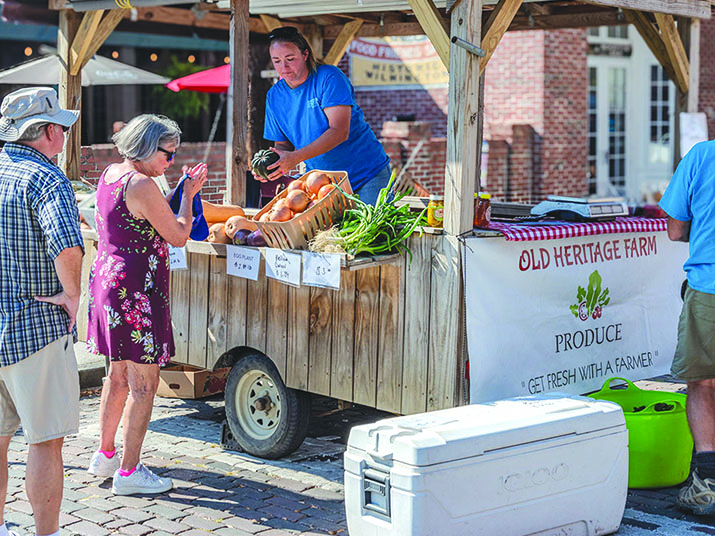Aging in place

A silver tsunami is coming.
That’s according to statistics from the AARP, or American Association of Retired Persons, which finds that over the past several decades, about 10,000 Americans a day have turned 65. By 2024, that number will increase to 11,200 a day, a total of 4.1 million yearly. For those retiring at or around this age, that may mean moving to a residential, long-term care services facility – gray hair or not.
Enter the continuing care retirement community or CCRC, a stand-alone independent living community that allows older adults to live in one place for as long as they need, regardless of the level of care.
“The value proposition for residents is that as you age and become familiar with one place that the last thing you want is to have to uproot and leave if and when you need a higher level of care,” said Zane Bennett, executive director of Porters Neck Village, a nonprofit, 58-acre continuing care retirement community just north of Wilmington. “The continuing care model allows for greater flexibility, among other things, with the assurance that a well thought out care plan is in place.”
Based on an age-in-place philosophy, CCRCs have existed for more than a century, according to LeadingAge, a nonprofit agency serving older adults, beginning in Europe as a way to shelter and care for the aged. Many early CCRCs were religiously affiliated.
Fast forward to the 1960s, when the U.S. witnessed a significant jump in older adults and a corresponding increase in CCRCs. Today, the number of CCRCs across the country stands at around 2,000, according to MyLifeSite, a senior living consultant group. According to the North Carolina Department of Insurance, there are 59 CCRCs in the Tarheel state, with 20,000 plus residents.

Reasons older adults choose a CCRC over a more traditional retirement setting are many, said Bennett, but common to almost all is autonomous decision-making. A recent industry rebrand reflects this, said the Florida native who has resided in Wilmington for 10 years.
“In 2012-2013, the industry rebranded from continuing care retirement communities to life plan communities,” said Bennett. “And the big reason was that after numerous focus groups, they found that the common denominator was that residents of these types of communities saw value in having a plan and being in the driver’s seat of their decision-making when they still could.”
CCRCs also foster purpose, said Bennett.
“It’s a purposeful life,” he said. “They’re finding new hobbies, helping others, volunteering and tending to our facility’s residential garden.”
An active life at Porters Neck Village and other similar life plan communities is equally part of the plan, said Bennett.
“The extensive programming and amenities, the multiple restaurants – we even had a group of residents go ziplining a couple weeks ago,” he said. “But at any point should there be a need for a higher level of care, it’s there.”
Levels of care at most CCRCs include independent living, assisted living, skilled nursing and memory care.
With a corporate career including stays in Chicago, Houston, Baltimore and Nashville, among other American cities, Porters Neck Village resident Bob Mitchell, 77, said he chose the CCFC age-in-place model because it aligned with his personal philosophy.
“Everything in life is about risk management,” said Mitchell. “A CCRC allows you to basically sort of buy insurance that if you need to graduate from independent living to assisted living or to memory care or (skilled) nursing ... you’ve got that available.”
Most CCRCs are nonprofit organizations, and many require a one-time entrance fee ranging from tens of thousands to hundreds of thousands of dollars, depending on residence and contract type. The entrance fee helps pay for future healthcare costs as residents move through the continuum of care. In many cases, the entrance fee is partially or fully refundable, depending on the contract type.
Residents also pay monthly fees covering amenities and services like dining, housekeeping, maintenance, transportation and social activities. These fees vary based on the level of care required.
“I wanted to find a community that had a strong financial position so that they would be around the time that I was here,” said Mitchell, a one-time board member at Porters Neck.
For 75-year-old Susan Maruyama, who spent life on both coasts as a publishing professional, the CCRC model was an option that almost wasn’t.
“We came to Wilmington in late 2022,” said the Massachusetts native. “And we actually came to Wilmington because we had found a CCRC … that we really liked, and we had put a lot of money down in a deposit.”
But soon, “red flags started to pop up,” said Maruyama, citing communication and coordination difficulties with management.
So Maruyama and her husband, who worked in the movie industry alongside the likes of George Lucas, started searching for other Port City CCRCs. That’s when they found Porters Neck Village.
“One of the things you’ll learn in your research is that we really have no precedent as a generation,” she said. “Our parents weren’t thinking of CCRCs. They were nothing that anybody really put into their investment portfolio or anything like that, and no one really knew what they needed to look for or should look for.”
Bennett said prospective residents should look for licensing when choosing a CCRC.
“CCRCs are approved and regulated by the N.C. Department of Insurance under their special entities division,” he said. “There are no federal regulations; however, our industry does interact with a lot of federal agencies depending on the structure. …For example, if there’s skilled nursing on site, you’ve got CMS and OIG, and for workplace standards you have OSHA.”
To meet these standards, a CCRC-life plan community must be well-planned and constructed – historically not an easy thing.
“Cost of construction is a high barrier to entry into the industry,” said Bennett, “because to build a new community today with, for example, 300 units, a mixture of independent living, assisted living and skilled nursing, you’re looking at upwards of $250 to $300 million.”
Whether a community is newly built or long-established, however, fans of the CCRC model seem to be in it for the long haul.
“When someone comes to us,” said Bennett, “they’re typically in their 70s. However, we’ve got residents here from ages 63 to 104.”
Bennett said some residents have lived at Porters Neck for more than 20 years.
Despite years and age ranges, certain recognizable CCRC constants remain.
“We keep our own doctors if we want, and we lead an independent life, and that’s pretty nice,” said Maruyama.
“Everybody wants to do that. Everybody should be so lucky. We love it here.”
And then there’s the network of friends, one of the biggest draws for residents like Maruyama and Mitchell, the former sharing an anecdote about her husband who attends a weekly men’s group and also paints.
“My husband goes to this men’s coffee twice a week, and they can’t talk religion and can’t politics, and they have speakers come in from time to time,” said Maruyama. “He loves it. Then he’s got this following because his artwork is now on display on the walls and around the community, and he’s got a little fan club of 95-year-old ladies and guys.”
For Mitchell, some of the best advice he’s heard regarding promoting the benefits of a CRCC came from another resident over dinner.
“He summed it up this way – don’t wait too long. Get here before you have to get here.”















